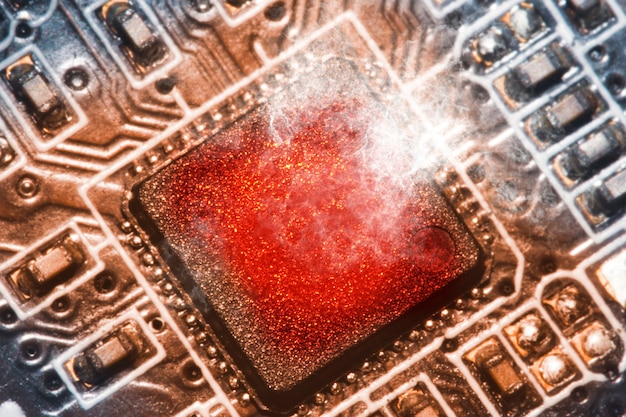Quantum Computing in 2025: Key Advancements and Future Outlook

Advertisements
Unveiling the Latest Advancements in Quantum Computing: A 2025 Outlook, this article explores breakthroughs in qubit technology, algorithm development, and error correction, highlighting their potential impact on various industries and the challenges that remain for widespread adoption.
Get ready to explore the revolutionary world of quantum computing and what’s on the horizon. Unveiling the Latest Advancements in Quantum Computing: A 2025 Outlook reveals the groundbreaking progress and potential impact this technology holds for the future.
Advertisements
Quantum Computing’s Transformative Potential
Quantum computing stands on the precipice of revolutionizing numerous fields, from medicine to materials science. Unlike classical computers that use bits representing 0 or 1, quantum computers leverage qubits. These qubits, thanks to the principles of quantum mechanics like superposition and entanglement, can exist in multiple states simultaneously, allowing quantum computers to perform calculations far beyond the reach of their classical counterparts.
The year 2025 is anticipated to be a pivotal one for quantum computing, with advancements poised to transition from theoretical possibilities to tangible applications. This progress isn’t just about faster calculations; it’s about enabling entirely new approaches to problem-solving that were previously deemed impossible.
Advertisements

The Quantum Leap: What Makes It Different?
To fully grasp the advancements expected by 2025, it’s essential to understand what sets quantum computing apart. Superposition enables qubits to represent 0, 1, or any combination thereof, drastically increasing computational possibilities. Entanglement, another key property, links two or more qubits in such a way that they become interconnected, regardless of the distance separating them. This allows for complex parallel computations.
These phenomena enable quantum computers to tackle problems that are intractable for classical computers. Quantum computers can efficiently factor large numbers, which has implications for cryptography. They can also simulate molecular interactions, aiding in drug discovery and materials science.
- Exponential Speedup: Quantum algorithms, like Shor’s algorithm, demonstrate the potential for exponential speedup compared to the best-known classical algorithms for certain problems.
- New Possibilities: Quantum simulation allows researchers to model complex systems with unprecedented accuracy, leading to discoveries in various scientific domains.
- Enhanced Optimization: Quantum optimization algorithms can solve complex optimization problems, improving logistics, finance, and artificial intelligence.
Quantum computing’s transformative potential also introduces challenges. Building and maintaining quantum computers requires extremely low temperatures and precise control over qubits. Overcoming these challenges is critical for realizing the full potential of quantum computing by 2025.
Advancements in Qubit Technology
Qubit technology is at the heart of quantum computing, and significant advancements are expected by 2025. Different types of qubits, including superconducting qubits, trapped ions, and photonic qubits, are being developed, each with its unique strengths and challenges. Improving the stability, coherence, and scalability of qubits is crucial for building practical quantum computers.
Researchers are actively exploring novel materials and fabrication techniques to enhance qubit performance. The goal is to create qubits that can maintain quantum states for longer durations and interact with each other with high fidelity, enabling more complex quantum computations.
Superconducting Qubits
Superconducting qubits, based on superconducting circuits, are among the most widely used qubit technologies. They offer relatively easy control and fabrication, making them attractive for building larger quantum processors. Advancements in materials and circuit design are expected to improve the coherence and fidelity of superconducting qubits.
Trapped Ion Qubits
Trapped ion qubits, which use individual ions trapped and controlled by electromagnetic fields, offer high coherence times and excellent fidelity. Scaling up trapped ion systems is a challenge, but progress in ion trap technology and laser control is paving the way for more powerful quantum computers.

- Hybrid Qubit Systems: Combining different types of qubits into hybrid systems could leverage the strengths of each technology, leading to improved overall performance.
- Quantum Dot Qubits: Quantum dot qubits, based on trapping electrons in semiconductor nanocrystals, offer potential advantages in terms of scalability and compatibility with existing semiconductor manufacturing processes.
- Topological Qubits: Topological qubits, which encode quantum information in topological states of matter, are expected to be highly resistant to noise and decoherence, although they are still in early stages of development.
The pursuit of more robust and scalable qubit technologies will be a defining theme in quantum computing research leading up to 2025. These advancements will determine the feasibility of building quantum computers capable of solving real-world problems.
Quantum Algorithm Development
While hardware advancements are essential, the development of quantum algorithms is equally crucial for realizing the potential of quantum computing. Quantum algorithms are designed to exploit the unique properties of quantum mechanics to solve specific problems more efficiently than classical algorithms. Researchers are actively developing new quantum algorithms and refining existing ones to tackle a wider range of applications.
By 2025, we can expect to see more quantum algorithms that demonstrate practical advantages over classical methods. These algorithms will be tailored to specific industry needs, such as drug discovery, financial modeling, and materials science.
Shor’s Algorithm and Cryptography
Shor’s algorithm, which can efficiently factor large numbers, has significant implications for cryptography. The algorithm poses a threat to widely used encryption schemes like RSA, which rely on the difficulty of factoring large numbers. The development of quantum-resistant cryptographic methods is a key area of research to mitigate this threat.
Grover’s Algorithm and Search
Grover’s algorithm provides a quadratic speedup for searching unsorted databases compared to classical algorithms. Although the speedup is not as dramatic as Shor’s algorithm, Grover’s algorithm has broad applicability across various search and optimization problems.
- Variational Quantum Eigensolver (VQE): VQE is a hybrid quantum-classical algorithm used to find the ground state energy of molecules and materials. It has applications in drug discovery and materials science.
- Quantum Approximate Optimization Algorithm (QAOA): QAOA is another hybrid algorithm designed to solve combinatorial optimization problems. It has potential applications in logistics, finance, and machine learning.
- Quantum Machine Learning: Quantum machine learning algorithms leverage quantum computation to enhance machine learning tasks, such as classification, clustering, and dimensionality reduction.
The development and refinement of quantum algorithms will continue to drive the field forward, unlocking new computational capabilities and applications. Close collaboration between quantum algorithm developers and domain experts is essential to identify and address specific industry challenges.
Error Correction and Fault Tolerance
One of the major challenges in quantum computing is dealing with errors. Qubits are highly susceptible to noise and decoherence, which can corrupt quantum computations. Quantum error correction is essential for building fault-tolerant quantum computers that can perform complex calculations reliably. By 2025, significant progress in quantum error correction is expected.
Researchers are developing quantum error-correcting codes that can detect and correct errors without disturbing the quantum information. These codes require a large number of physical qubits to encode a single logical qubit, but the overhead is necessary for achieving fault tolerance.
Surface Codes
Surface codes are a leading approach to quantum error correction. They are based on arranging qubits in a two-dimensional grid and using local interactions to detect and correct errors. Surface codes are considered promising due to their relatively low overhead and compatibility with various qubit technologies.
Topological Error Correction
Topological error correction encodes quantum information in topological states of matter, which are inherently resistant to local perturbations. Topological codes offer the potential for very high fault tolerance, but they are still in early stages of development.
- Concatenated Codes: Concatenated codes combine multiple layers of error correction to achieve higher levels of fault tolerance. They are computationally intensive but can provide robust protection against errors.
- Hardware-Efficient Codes: Researchers are also exploring hardware-efficient error-correcting codes that reduce the overhead in terms of qubits and control operations.
- Error Mitigation Techniques: In addition to error correction, error mitigation techniques can be used to reduce the impact of errors on quantum computations without fully correcting them.
The development of effective quantum error correction schemes is critical for building practical quantum computers. By 2025, we can expect to see more robust error correction techniques that enable larger and more complex quantum computations.
Industry Applications and Impact
Quantum computing has the potential to transform numerous industries, including healthcare, finance, materials science, and artificial intelligence. By 2025, we can expect to see more concrete examples of quantum computing being applied to solve real-world problems. These applications will drive further investment and development in the field.
Quantum computing can accelerate drug discovery by simulating molecular interactions and identifying potential drug candidates. In finance, quantum algorithms can optimize investment strategies and improve risk management. In materials science, quantum simulations can aid in the design of new materials with enhanced properties.
Healthcare and Drug Discovery
Quantum computing can revolutionize healthcare by enabling the simulation of complex biological systems and the design of personalized medicines. Quantum algorithms can analyze large datasets to identify patterns and predict patient outcomes.
Finance and Investment
In finance, quantum computing can optimize investment portfolios, detect fraud, and improve risk management. Quantum algorithms can analyze market data and identify arbitrage opportunities.
- Materials Science and Engineering: Quantum simulations can aid in the discovery of new materials with enhanced properties, such as superconductivity and high strength. These materials can have applications in various industries, including electronics, aerospace, and energy.
- Artificial Intelligence and Machine Learning: Quantum machine learning algorithms can enhance machine learning tasks, such as classification, clustering, and dimensionality reduction. Quantum computers can train machine learning models faster and more efficiently.
- Logistics and Supply Chain Optimization: Quantum optimization algorithms can solve complex logistics and supply chain problems, improving efficiency and reducing costs.
The impact of quantum computing on various industries is expected to grow significantly by 2025. As quantum computers become more powerful and accessible, they will unlock new opportunities for innovation and problem-solving.
Challenges and the Road Ahead
Despite the rapid advancements in quantum computing, significant challenges remain. Building and maintaining quantum computers is technically challenging, and scaling up qubit systems while maintaining coherence and fidelity is a major hurdle. Quantum error correction is also a complex and computationally intensive task. Overcoming these challenges is essential for realizing the full potential of quantum computing.
The road ahead for quantum computing involves continued research and development in qubit technology, quantum algorithms, and error correction. Collaboration between academia, industry, and government is crucial for driving progress and fostering innovation. Investing in quantum education and training is also essential to build a skilled workforce capable of harnessing the power of quantum computing.
Scalability and Coherence
Scaling up qubit systems while maintaining coherence and fidelity remains a major challenge. As the number of qubits increases, it becomes more difficult to control and protect them from noise and decoherence. Developing scalable qubit architectures and improving qubit coherence are key areas of research.
Quantum Error Correction
Quantum error correction is essential for building fault-tolerant quantum computers, but it is also a complex and computationally intensive task. Developing more efficient and robust error-correcting codes is a major priority.
- Quantum Software and Programming Tools: Developing quantum software and programming tools that are easy to use and accessible to a wider range of developers is crucial for fostering innovation.
- Quantum Education and Training: Investing in quantum education and training is essential to build a skilled workforce capable of harnessing the power of quantum computing.
- Collaboration and Partnerships: Collaboration between academia, industry, and government is crucial for driving progress and fostering innovation in quantum computing.
The challenges in quantum computing are significant, but the potential rewards are immense. Continued investment in research and development, coupled with collaboration and education, will pave the way for a quantum future.
| Key Element | Brief Description |
|---|---|
| ⚛️ Qubit Tech | Advancements in superconducting, trapped ion, and photonic qubits. |
| ⚙️ Algorithms | Development and refinement of algorithms like Shor’s and Grover’s. |
| 🛡️ Error Correction | Progress in surface codes and topological error correction methods. |
| 🏢 Industry Impact | Applications in healthcare, finance, materials science, and AI sectors. |
Frequently Asked Questions
▼
The main types include superconducting qubits, which are based on electrical circuits; trapped ion qubits, which use individual ions; and photonic qubits, which use photons to represent quantum information.
▼
Quantum error correction is crucial because qubits are very susceptible to noise, which can corrupt computations. Error correction helps to maintain the integrity and reliability of quantum computations.
▼
In healthcare, quantum computing can be used for drug discovery by simulating molecular interactions, designing personalized medicines, and analyzing large datasets to predict patient outcomes.
▼
Quantum computing can benefit finance by optimizing investment portfolios, detecting fraud, improving risk management, and analyzing market data to identify arbitrage opportunities.
▼
The main challenges include scaling up qubit systems while maintaining coherence and fidelity, developing effective quantum error correction methods, and building a skilled workforce to harness quantum technology.
Conclusion
As we look towards 2025, the advancements in quantum computing promise a transformative impact across various industries. The ongoing developments in qubit technology, quantum algorithms, and error correction are paving the way for practical applications that can address some of the world’s most complex challenges. While significant hurdles remain, the progress made thus far underscores the immense potential of quantum computing to revolutionize science, technology, and society.